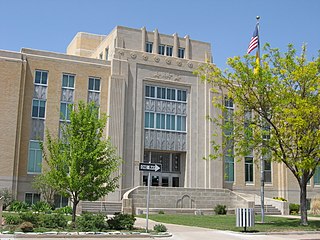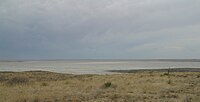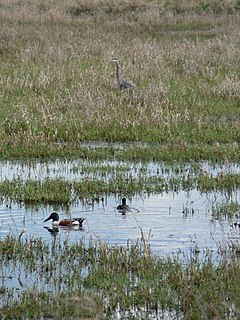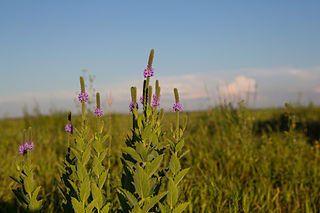| Grulla National Wildlife Refuge | |
|---|---|
 Flat playa surface of Arch Lake | |
 | |
| Location | Roosevelt County, New Mexico / Bailey County, Texas, United States |
| Coordinates | 34°05′43″N103°04′00″W / 34.09528°N 103.06667°W Coordinates: 34°05′43″N103°04′00″W / 34.09528°N 103.06667°W |
| Area | 13.1 km2 (5.1 sq mi) |
| Elevation | 1,177 m (3,862 ft) |
| Established | 1969 |
| Operator | U.S. Fish and Wildlife Service |
| Website | Grulla NWR |
Grulla National Wildlife Refuge is located primarily in eastern New Mexico in Roosevelt County, southwest of the intersection of State Highway 88 and the Texas - New Mexico border about 25 miles southeast of Portales, New Mexico and southeast of the tiny community of Arch. A very small part of the refuge extends eastward into western Bailey County, Texas. [1]

New Mexico is a state in the Southwestern region of the United States of America; its capital and cultural center is Santa Fe, which was founded in 1610 as capital of Nuevo México, while its largest city is Albuquerque with its accompanying metropolitan area. It is one of the Mountain States and shares the Four Corners region with Utah, Colorado, and Arizona; its other neighboring states are Oklahoma to the northeast, Texas to the east-southeast, and the Mexican states of Chihuahua to the south and Sonora to the southwest. With a population around two million, New Mexico is the 36th state by population. With a total area of 121,592 sq mi (314,920 km2), it is the fifth-largest and sixth-least densely populated of the 50 states. Due to their geographic locations, northern and eastern New Mexico exhibit a colder, alpine climate, while western and southern New Mexico exhibit a warmer, arid climate.

Roosevelt County is a county located in the U.S. state of New Mexico. As of the 2010 census, the population was 19,846. Its county seat is Portales. The county was created in 1903 from Chaves and Guadalupe counties and named for President Theodore Roosevelt. The county's eastern border is the Texas state line.

Texas is the second largest state in the United States by both area and population. Geographically located in the South Central region of the country, Texas shares borders with the U.S. states of Louisiana to the east, Arkansas to the northeast, Oklahoma to the north, New Mexico to the west, and the Mexican states of Chihuahua, Coahuila, Nuevo León, and Tamaulipas to the southwest, and has a coastline with the Gulf of Mexico to the southeast.
Contents
The central focal point of the Grulla National Wildlife Refuge is an ephemeral salt lake or saline playa – a shallow basin that collects runoff from the surrounding drainage area during heavy downpours but then often dries completely due to evaporation. This playa lake has been known by various names. Current USGS topographic maps and most commercially available maps of this region refer to this saline playa simply as "Salt Lake". [2] [3] Back in the early 1880s, this playa was part of the DZ Ranch, and those familiar with the ranch often favor the name "DZ Lake". The lake is also frequently called "Arch Lake" after the nearby community of Arch, New Mexico, located around 6 km to the northwest. [4] [5]

A salt lake or saline lake is a landlocked body of water that has a concentration of salts and other dissolved minerals significantly higher than most lakes. In some cases, salt lakes have a higher concentration of salt than sea water; such lakes can also be termed hypersaline lakes. An alkalic salt lake that has a high content of carbonate is sometimes termed a soda lake.

The United States Geological Survey is a scientific agency of the United States government. The scientists of the USGS study the landscape of the United States, its natural resources, and the natural hazards that threaten it. The organization has four major science disciplines, concerning biology, geography, geology, and hydrology. The USGS is a fact-finding research organization with no regulatory responsibility.
The word grulla is Spanish for crane. When wet, the playa lake provides habitat to sandhill cranes and the grasslands within the refuge provide habitat to other birds such as ring-necked pheasants, lesser prairie chickens, and scaled quails. [6]

Spanish or Castilian, is a Romance language that originated in the Iberian Peninsula and today has hundreds of millions of native speakers in Spain and the Americas. It is a global language and the world's second-most spoken native language, after Mandarin Chinese.

The sandhill crane is a species of large crane of North America and extreme northeastern Siberia. The common name of this bird refers to habitat like that at the Platte River, on the edge of Nebraska's Sandhills on the American Plains. This is the most important stopover area for the nominotypical subspecies, the lesser sandhill crane, with up to 450,000 of these birds migrating through annually.

The lesser prairie chicken is a species in the grouse family. It is a medium to large bird, striped white and brown, slightly smaller and paler than its near relative the greater prairie chicken. Adults range from 15.0-16.1 in (38-41 cm) in length and 22.1-28.7 oz in weight.
The refuge has no facilities other than a parking lot and trails and is administered by Muleshoe National Wildlife Refuge in Texas. It was often used in the mid 2000s as a training site for the Eastern New Mexico University cross country teams.

Muleshoe National Wildlife Refuge is a 6,440-acre (26.1 km2) wildlife refuge located about twenty miles (32 km) south of Muleshoe, Texas on Texas State Highway 214. It is the oldest National Wildlife Refuge in the U.S. state of Texas, having been established as the Muleshoe Migratory Waterfowl Refuge by executive order of President Franklin D. Roosevelt in 1935. Roosevelt issued a proclamation in 1940 changing the name to the Muleshoe National Wildlife Refuge. In 1980, Muleshoe National Wildlife Refuge was designated as a National Natural Landmark by the National Park Service.
- Saline playa within Grulla National Wildlife Refuge
- Sandhill cranes near Grulla National Wildlife Refuge


















